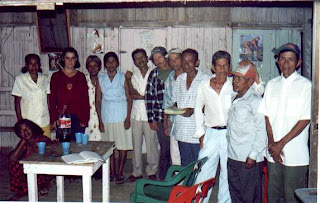




BUNCHE, ESMERALDAS
The visit was coordinated by Fernando Godoy, director of the Fundación de Desarrollo Social (social development foundation) based in Atacames. On the way to Bunche we stopped in the beachtown of Muisne. We arrived by motorboat since all access roads are not anymore. Señor Clemente Paneso, acting priest when the padre cannot make it from Muisne, had picked us up from Macará to escort us home. His sister in law, the unique Carmen, was to be our minder and landlady. She and a busy Paneso became tireless guides to many activities.
We were lucky to arrive the same day as the town celebrates their patron saint, San Jacinto. A new statue carved in Cuenca was to replace the old and well loved wooden saint, and it was scheduled to arrive that day. In the afternoon the procession arrived by boat. San Jacinto was paraded through town by a large crowd who chanted rythmic hymns and escorted by drumming, before being taken to the church and placed along his predecesor, who now had an uncertain future. A musical service was offered for the reception. So Bunche launched into a few days of celebration. Preparations included "la minga", a communal cleaning of streets and public spaces. We walked up the hills to some beautifull waterfalls in the Aguacate river, a place which is to become Bunches’ fresh water supply point to replace the salty wells in town. On the way, Paneso and Gringo taught us about native plants and their uses; the hard as ivory Tagua palm seed, the palm frond that is bleached and softened to make the famous Panamá hats in Manabí, the coastal Balsa wood, the multipurposed Chonta palm, wild fruits like Obos (small wild plums), Pepa de pán (breadfruit), Guava verde (large beanlike pod), to name a few.
Also walked along the beach to visit the neighbouring fishing town of Cabo san Francisco. Then, a simple task as going to get some fresh water, a scarce comodity in the coast, from a stream became an odyssey. With the rising tide we jumped in a dugout canoe, filled it with empty containers and put our safety in the hands of Pila, a 10 year old selfmade jack of all trades. After about 2 hours we found the probervial spring, disembarked and stocked up on the vital fluid.
During our stay we had conversations with a few buncheanos about some pressing matters. There is the well known problem of prawn farming. Large areas of mangrove, which used to be habitat of some of the staples in Bunches’ diet (Concha, Cangrejo, Jaiba, various species of fish), have been transformed into ponds to raise the expensive crustacean. Now, due to a virus affecting it, half the ponds are empty of Camarón, or any other dweller. On top of this, some people think the chemicals used in the farms are filtering through into the remaining healthy ecosystems. Another setback are the plagues destroying cash crops these people used to depend on (Coconut, Cacao, Coffee, Banana). Causes are unclear but the results are felt. Health is another issue, a health centre needs to be finished to house permanent staff and store medical supplies, and hopefully a much needed pathology unit on site. Our last evening we had a meeting with the Comité Pro-mejora de Bunche (local improvements comitee) to discuss our stay and some initiatives the community is working on, such as an experimental Concha (seashell) farms. Concha harvest is a prime activity and has been overexploited, so now some areas have been set aside to protect it.
Despite all the obstacles and isolation, Bunche knows how to have a good time, and our last night we spent partying in the name of San Jacinto in the main square. We danced to the sounds of cumbia, salsa and ballenato, ate ceviche de concha and calamari, and gulped the old sugar cane rum. The next morning before departure, we attended the baptism of 11 children. Then boated it back to Muisne, together with the priest, who was a long way from his home, India.
MoreCostal Marine Reserve
Comments